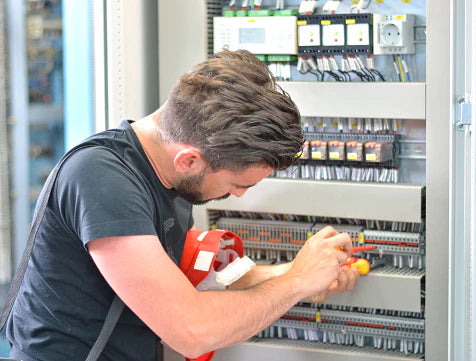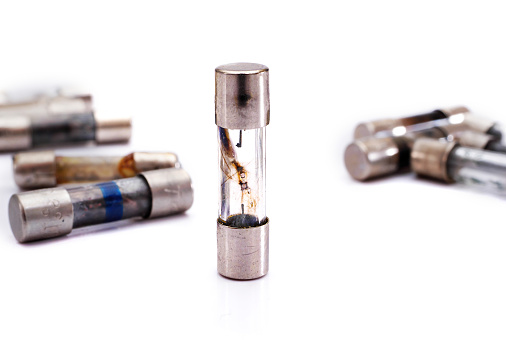Smart Breaker VS Fuse– What is the Difference& Which is Better?
Fuse vs. smart breaker is a fairly prevalent debate in many homes. Many residents have trouble updating their older homes to accommodate modern technology. Your electrical and service distribution panels might hold the key to keeping your home's electrical system operating efficiently.
Fuse boxes, which prevent overloads and safeguard the electrical circuits like circuit breakers do, are still present in some of these older homes. While they both halt the flow of power, they operate in quite different ways.
The electrical panel has both circuit breakers and fuses. The electrical panel in a home is a metal service box. It receives the main power from your utility provider. It then distributes electricity to the different circuits inside your house. The meter, which belongs to your utility provider, is located within the main electrical panel.
Electricity travels from there to the panel, which belongs to and must be maintained by the homeowner. Power is sent to the different circuits at the panel, where fuses or smart breakers are used to safeguard individual circuits from overcurrent.
What is a Fuse & How does it Work?


An over-current safety device called a fuse, it is a component of the service distribution panel. In essence, it is a chunk of metal that melts when it gets too hot.
There are many various kinds of fuses. The most typical one is manufactured using a thin wire filament. This filament is encased in glass or ceramic and placed in a metal casing. The fuse is connected to the wiring for the whole home's electrical system, which is located in a central fuse box. The fuse normally permits electricity to freely flow through the filament between circuits.
The filament will melt in the case of an electrical overload, cutting off the current before it can harm your home's wiring or pose a fire threat. This will halt the flow of power.
A fuse that has blown can never be used again. A replacement fuse of the same kind and amperage rating must be used in its place. Fuses are available in a range of amperage ratings to accommodate differing electrical current capacities. Fuse ratings should always be a little bit greater than the circuit it protects typical operating current for practical reasons.
NEVER switch out a fuse with one that is higher rated than the one the circuit's designer intended for safety reasons. Allowing the excessive current to go through increases the risk of electrical fires by warming the wires.
What is a Smart Breaker?

Another safety device with an inbuilt switch mechanism that can trip in the event of a power surge is a smart breaker. A bimetallic strip or an electromagnet is used in the most basic domestic circuit breaker, coupled with a straightforward switch.
The switch permits electrical current to flow from a bottom terminal to an upper terminal when it is in the ON state. A metal lever in the switch may be moved to the off position by an electromagnet when a dangerous electrical current is present, breaking the current. Bimetallic strips are made up of two strips made of two different kinds of metal. When too much current flows through them, the thinner of the two strips bends, turning the switch off and severing the connection.
Real-time data collection and circuit safety monitoring are capabilities of smart breakers. You may turn the circuit on and off at any time, anywhere, using the remote control on your smartphone. Also, the smart circuit breaker supports voice control through Google Home and Amazon Alexa.
Fuse Box VS Smart Breaker: Differencds & Applications
Fuses are often less expensive and are available at any hardware store, but smart breakers have other functions that go beyond preventing overheating, such as protecting against electric shock.
Based on practical considerations like operating time and functionality, the table below lists the key distinctions and applications.
|
Features |
Fuse |
Smart Breaker |
|
Function |
Detection & interruption |
Detection & interruption& monitor& remote control& set schedule& voice command |
|
Operation Principle |
Based on a conducting material’s heating property |
Based on a electromechanical principle – a switching mechanism& intelligent chip built-in |
|
Operation Mode |
Completely automatic Needs manual replacement after operation |
Resets quickly after operation |
|
Response Time |
~ 0.002 seconds |
0.1-0.2 seconds |
|
Breaking Capacity |
Small |
Large |
|
Protection |
Protects against overload |
Protect against overload & short-circuits& over-current & over-voltage& over-temperature |
|
Application |
Low current electronic equipment |
Large current power equipment |
Which Provides my Home with Better Service—a Fuse or a Smart Breaker?
There was a lot less demand for power several decades ago since there were fewer electrical equipment and appliances in every room of every home. Prior to the 1960s, fuse boxes provided 60-amp service, which was the norm and enough. The majority of contemporary dwellings nowadays need up to 200-amp service.
Fuse boxes do not provide enough energy for a modern household, in addition to being obsolete and challenging to repair. Usually, they don't have the special circuits needed for big equipment like air conditioners, dishwashers, and dryers. Homeowners who have fuse boxes routinely overload circuits and blow fuses, which is a common occurrence.
Despite the fact that your fuse box might seem to give acceptable service, this could be the consequence of modifications made by past owners. For instance, it is simple to place a 30-amp fuse on a 15-amp circuit, allowing the homeowner to consume more power than the original designer intended for a single circuit.
Eventually, allowing an excessive current to flow through uncontrolled might result in a number of fire dangers. In such sad situations, many new homeowners may continue to utilize fuses. This dangerously enables too much current to flow through a single circuit. They have no way of knowing if this has been done to their fuse box in the past.
These are several red flags that indicate your fuse box is inadequate for your home's requirements:
- The fuse replacement is required frequently
- Some appliances cannot be operated simultaneously
- The fuse box makes popping or hissing noises
- The wall near your electrical outlets or switches feels warm
Conclusion
A qualified electrician should evaluate your home's electrical system and install a smart breaker if you see any of the aforementioned symptoms. It's also vital to be aware that specific homeowner insurance policies could exclude coverage for properties with fuse boxes because of the possible safety risk associated with negligent maintenance.
Even if your house already has a circuit breaker panel, it's still conceivable that it won't be sufficient to meet your house's electrical requirements. You could own or desire more technological toys, gadgets, and appliances. The greatest choice in this situation would be a smart breaker. Please get in touch with us if you need help maintaining a safe and enjoyable home environment.



